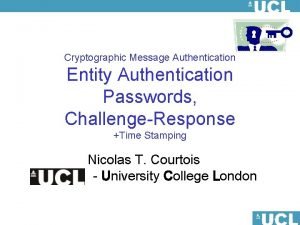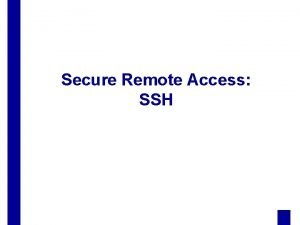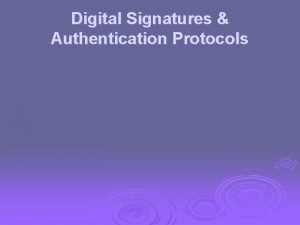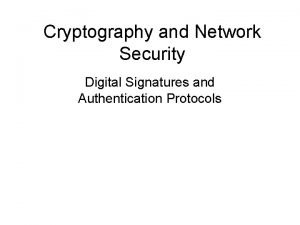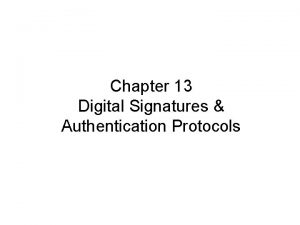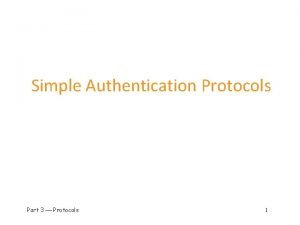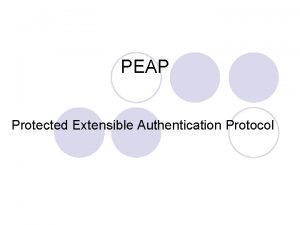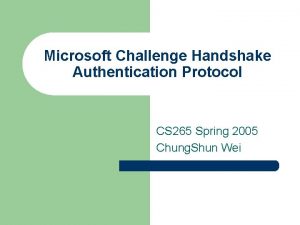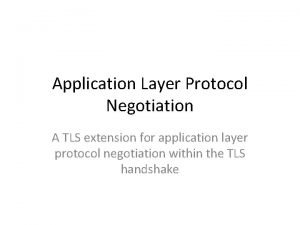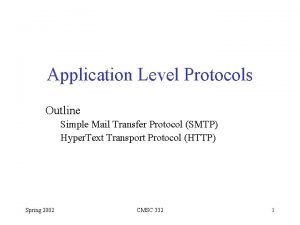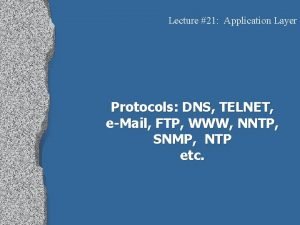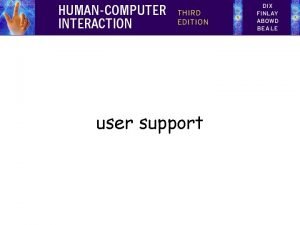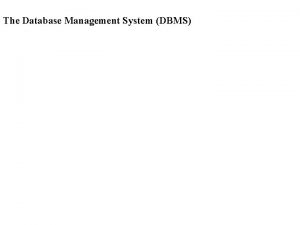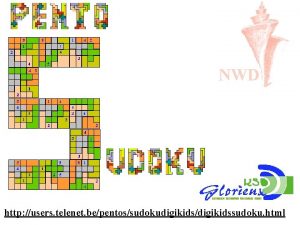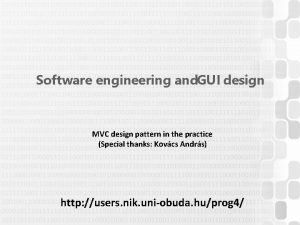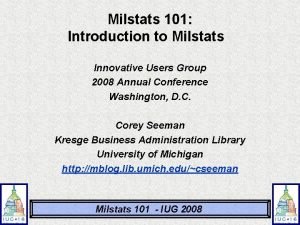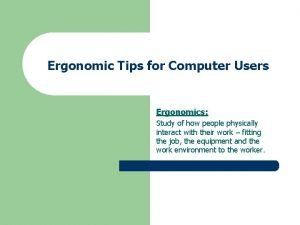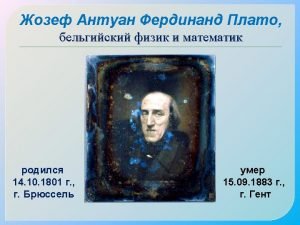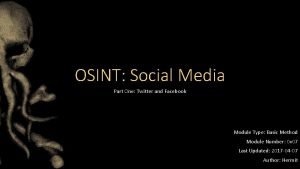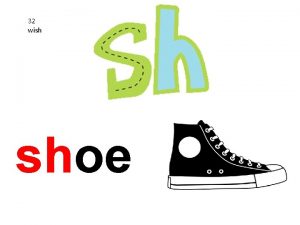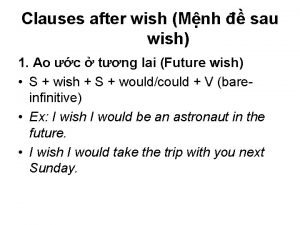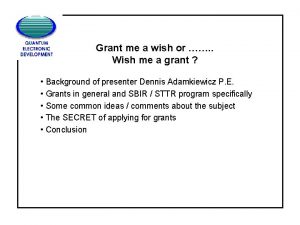Authentication Protocol Authentication Application Authentication Protocol Users wish



























- Slides: 27

Authentication Protocol Authentication Application

Authentication Protocol Users wish to access services on servers. used to convince each others identity and to exchange session keys. Require the user to prove his identity for each service invoked Require that servers prove their identity to clients Provide security in a distributed architecture consisting of dedicated user workstations (clients), and distributed or centralized servers. may be one-way or mutual.

Security Concerns key concerns are 1. Confidentiality: -encrypt identification and session key info. 2. Timestamp: - to prevent replay attacks. by using sequence numbers 3

Kerberos In Greek mythology, a many headed dog, the guardian of the entrance of Hades

What is Kerberos? Developed as part of Project Athena at MIT Open Source hence freely available Provides centralised private-key third-party authentication in a distributed network Provides single sign-on capability Passwords (i. e: Secret Key) never sent across network Key revocation can be achived by disabling a user at KDC.

How does Kerberos Works? Uses an Authentication Server (AS) Knows all user passwords, and stores in a DB Shares a unique secret key with every user. Send TGT an encrypted ticket granting ticket contains a lifetime and timestamp

How does Kerberos Works? Uses a Ticket Granting Server (TGS) Issues tickets to users authenticated by AS. Encrypted with a key only known by AS and TGS Returns a service granting ticket Service granting ticket contains timestamp and lifetime

Kerberos Dialog Message Exchanges Simplified Client approach asks authentication server for ticket AS exchange to obtain ticket-granting ticket AS grants ticket TGS exchange to obtain service granting ticket Client sends ticket to server Client/Server obtain service authentication exchange to


XYZ Service SERVER Think “Kerberos Server” and don’t let yourself get mired in terminology. Ticket Granting Service Key Distribution Center Authen. Tication Service USER Gurukul Desktop Computer

Ticket Granting Service XYZ Service “I’d like to be allowed to get tickets from the Ticket Granting Server, please. Key Distribution Center Authen. Tication Service UID&PW USER Gurukul Desktop Computer UID

XYZ Service “Okay. I locked this box with your secret password. If you can unlock it, you can use its contents to access my Ticket Granting Service. ” Ticket Granting Service Key Distribution Center Authen. Tication Service USER Gurukul Desktop Computer

Ticket Granting Service XYZ Service Key Distribution Center TGT ord My Passw USER Gurukul Desktop Computer Authen. Tication Service

TGT Because Gurukul was able to open the box (decrypt a message) from the Authentication Service, he/she is now the owner of a “Ticket. Granting Ticket”. The Ticket-Granting Ticket (TGT) must be presented to the Ticket Granting Service in order to acquire “service tickets” for use with services requiring Kerberos authentication. The TGT contains no password information.

Kerberos Realms a Kerberos environment consists of: a Kerberos server a number of clients, all registered with server application servers, sharing keys with server A Kerberos Realm Set of managed nodes that share the same Kerberos database To improve the performance To over come failure issues due too single AS & TGS

Multiple Kerberi Kerberos server in each realm shares a secret key with one another There must be trust between the servers i. e. each server are registered with one another Does not scale well


Kerberos Version 4 Pc=password of client v ID + c P c+ 1 - ID 3 - I D et k c i T 2 - c +T icke t Ticket=Ekv[IDc, ADc, IDv] IDc= User id of client kv=Secret Key between AS and V (Server)

Kerberos Version 4 Weaknesses Big load on AS (Provide secondary ticket -granting servers) Repeated password entry (Password to AS seldom, tickets from TGS when needed, based on AS authentication)

Version 4 Authentication Dialogue Problems: Lifetime associated with the ticket-granting ticket If to short repeatedly asked for password If to long greater opportunity to replay The threat is that an opponent will steal the ticket and use it before it expires Henric Johnson 20

Strategies and Countermoves What opponents of 4 can do Wait for long-lived ticket-granting tickets and then reuse Capture service-granting tickets and then use remaining time Antitheft of ticket-granting tickets AS provides both client with a secret, securely Done by sending a session key This procedure also makes servicegranting tickets reusable

Kerberos Organization Called a realm, it includes: Kerberos UID server, which includes: and hashed password for each user Shared Kerberos TGS secret key with each user server includes both AS and Inter-realm Kerberos issues servers in each realm are registered with each other (share a secret key) TGS in server realm issues tickets to client on other realm (i. e RTGS)

Kerberos Version 5 Fixes version 4 environmental shortcomings New elements for AS exchange: Realm, Client/server authentication exchange Sub Options, Times, Nonce key, sequence number Kerberos Ticket Flags

Difference Between Version 4 & 5 Point of Discussion Version 4 Version 5 Encryption Algorithm Used DES only DES & its variant, IDEA etc. Identifiers IP Address only N/w Add, Type , length Message byte ordering Not Allowed Tickets Lifetime Small Renewable time span Authentication forwarding Same server only Any server in realm Inter-realm authentication Support (SCALING) No Single Peer-to-peer Yes Multiple Transitive (Cross-realm) Replay Caches Support No Yes Postdatabale Ticket Not Available Forwardable (New Ticket) Single ticket, same M/C, Same IP Current credentials to get valid on another M/C

Attacks on Kerberos Threats exist: Modification Attack: - Network address of a workstation. Replay Attack: -Eavesdrop while communication. PW Guessing Attack: - User pretend to be another user. Inter-session chosen Plaintext Attack: - As per V. 5 Draft Created by Mr. Sumit Patel

Kerberos Mechanism Used By Microsoft Passport Technology Windows NT

Version 5 – Continued Avoids double encryptions Avoids PCBC (vulnerable to a cipher block exchange attack) Session and sub-session keys Pre-authentication – makes password attacks more difficult (but not impossible)
 I wish + past tense
I wish + past tense Unreal wishes
Unreal wishes Security services x.800
Security services x.800 Iff
Iff Secure remote login ssh
Secure remote login ssh Digital signature authentication protocol
Digital signature authentication protocol Digital signature authentication protocol
Digital signature authentication protocol Digital signature authentication protocol
Digital signature authentication protocol Simple authentication protocol
Simple authentication protocol Define peap
Define peap Microsoft challenge handshake authentication protocol
Microsoft challenge handshake authentication protocol Application layer protocol negotiation
Application layer protocol negotiation Application level protocol
Application level protocol Dns application layer protocol
Dns application layer protocol Type of user support
Type of user support Office microsoft
Office microsoft Icebreaker about failure
Icebreaker about failure Naive users in dbms
Naive users in dbms Daily sudoku telenet
Daily sudoku telenet Users.nik.uni-obuda/kovacs.andras
Users.nik.uni-obuda/kovacs.andras Users office cern
Users office cern Innovative users group
Innovative users group Ergonomic tips for computer users
Ergonomic tips for computer users Users.telenet.be
Users.telenet.be Osint facebook
Osint facebook Fire safety for wheelchair users
Fire safety for wheelchair users 5 users of accounting information
5 users of accounting information External users of accounting information
External users of accounting information



